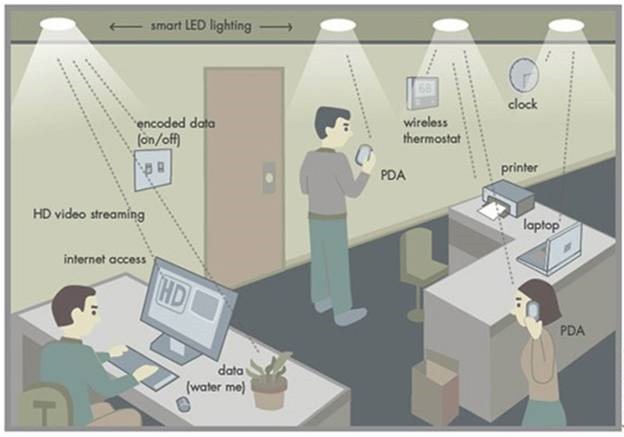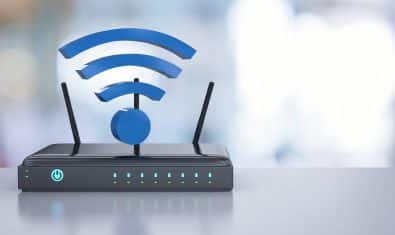A team of Chinese experts and specialists have successfully developed, and experimented an innovative way of gaining access to the Digital World of the Internet using the signals sent through the Light Bulb instead of Radio Waves as in Wi-Fi.
Scientists named it Li-Fi.
In case if you don’t know, Wi-Fi operates in the frequency range between 2.4 and 2.483 GHz. IEEE 802 (11a operates in the frequency range from 5.725 to 5.850 GHz. These are often referred to as the “2.4 GHz” and “5GHz” bands).
The term Li-Fi may not be new to many ears; in fact it is around since 2011, when Harald Haas had first used it in his TED Global talk on Visible Light Communication on this very context.
The Li-Fi technology operates under the principle that light can be used to carry Signals as an alternative to traditional radio frequencies; it keeps serving as long as there is no blockage of any kind, between the Light source and a Computer.
Chi Nan, the I.T Professor at Shanghai’s Fudan University, who also leads the Li-Fi research team (which includes scientists from the Shanghai Institute of Technical Physics of the Chinese Academy of Sciences) have said that, “One-watt LED Light Bulb may establish an Internet connection for four Electronic Gadgets at once.”, she added that, “A light bulb with embedded microchips can produce data rate as fast as 150Mbps.”
The current tools for Wireless Signal Transmission is expensive and less efficient, said Chi.
“Millions of base stations have been established for strengthening the signals of cell phones, but most of the energy is consumed for their cooling systems. The energy utilization rate is only five percent” she explained.
In today’s world where two thirds of the total population does not have internet access, and places like Pakistan, China and India, where over billion people combined don’t have this facility; gaining access to the Internet by just turning on the Light bulb will be nothing less than a dream come true.
According to Chi,
“Wherever there is a LED light bulb, there is an Internet signal. Turn off the light and there is no signal”
More importantly, according to the experts, the development of a series of key related pieces of technology, including light communication controls as well as microchip design and manufacturing, is still in an experimental period and there is still a long way to go to make Li-Fi a commercial success.
Despite the fact that the Technology is still in the experimental period, Netizens should be excited to view 10 sample Li-Fi kits that will be on display at the China International Industry Fair that will kick off on November 5 in Shanghai.
Photo courtesy: Extremetech


























what if i want to use internet with lights off
Attach it to a wifi router and put the router ouside.
They will surely have something in mind for that.
Infrared is also comes in LED :D
Infrared also comes in LED :D
for infrared there will be special LED’s but it is also a kind of light out from visible light spectrum.
visible light is more appropriate for internet sharing due to it’s shorter wave length.
this will improve the internet connection sharing but will not completely replace WiFi due to above mentioned problem and limitation of light from crossing hard materiel etc
i suggest using laser light in case u don’t want to be disturbed by the spreading light ……
for that purpose they have developed the function where you can set brightness of the light to minimun level which is not even vissible to naked eye.
:)
This is a joke, right? Does anyone even remember the infrared data connections on their Nokia phones? Even if your phone had it, it was so much easier to use bluetooth (“radio frequencies”) or something else. Like the article says, LiFi only works if there is no obstruction between the light bulb and your computer.
Today with wifi I can take my phone or tablet or laptop to another room away from the wifi router, and it works fine. What am I supposed to do with LiFi? Put the light bulb on a wire extension and move it from room to room???
the technology is in its early stages right now, give it some time to mature, and maybe it comes to a stage that we all will be willing to have it ASAP ! :)
However advanced stages it gets into, it cannot work around the obstruction issue.
I can understand it working in a very secure environment, where you want wireless communication, but not necessarily leakage of radio signals (like wifi through walls). But other than that…
well may be they use the infrared or ultra violet lights at hight scale(just guessing) which the naked eye cannot see
but if you look at the company leading the charge, it is purevlc (google it and also see wikipedia page on Li-Fi). vlc stands for visible light communication.
one can put a Bulb in every room you know.. whats the biggie?
Sure, if you’ve got money to waste. We live in a world where a good 802.11n wifi router costs under Rs 2,000 and can run ddwrt or openwrt (full control). will work in a large house, if you place it in the right location. LiFi? Nothing at all like that.
you seems to much smart @ss they knew much more then your thought
Seems like you lack critical thinking. Tell me, what practical use case can you show me where it is better than wifi? Not all of us work for FIA or IB or ISI and need something like this.
(And, really, there’s no way it can be better than wired.)
Hello,
Why do you fancy criticizing everything over praising ?
Don’t you think the Scientists who developed it would have thought about its limitations and have a better reason for this development ?
There would be a reason that they are developing this device, and as far as the coverage is concerned, Mirrors could be used to spread the light around.
Another thing, The Wifi Router may require you to purchase an Internet Connection whilst in the case of Light Fidelty wouldn’t hold true.
Just plug the Bulb and you have a working Internet Connection
Um…you think it will come with a free internet connection?
Oh dear. Oh dear dear dear.
you are absolutely right… i have the same point…
it can only be used in controlled environment.
in a laboratory testing, it reached upto 3Gbps but in normal condition, it was only 500 Mbps… the situation can go even worse if light pollution adds up… it would be a possible way of internet sharing but can not completely replace WiFi with power to reach any where and no straight line is necessary.
The above conversation has won the internet. When I read the article I thought ‘Would there be someone who would take this seriously’.
… I stand corrected.
Agreed!!! Just another wastage of time, energy & resources on the part of a bunch of fun loving scientists. Same happened in case of WiMAX. A lot time & money invested on a pointless technology when the whole world was looking for pure Fiber Optics Technologies as Metropolitan Networks & Wi-Fi as last mile network while WiMAX people were trying to convince us that WiMAX is the ultimate MAN & LAN solution. Dumb people!!!
I’m really surprised by the useless criticism on Li-fi development only because some people are unable to ‘think out of box’… This is for sure a great achievement… there are many situations where use of radio frequency for communication is not possible or not recommended, for instance in aircraft, near Power Generators, in radiology departments in hospitals, near high-tension power lines are few example came-up in my mind. Enhancement in Li-fi technology will open a new alternate signaling channel in such scenarios. Energy saving might become another benefit as this technology evolves. We should think beyond internet access too, this might be another alternate for near-field communication especially under high electro-magnetic interference etc.
Mogambo khush hua with your reply. The uses you have mentioned are quite justified but of very limited scope, certainly not enough to make this technology survive in the world of business where ordinary person is least concerned about electromagnetism, radiology & all the like. All he is concerned about is speed & good coverage without frequent disruptions in the communication. Let’s wait & watch while holding to our point of views!! will discuss about this after a couple of years or so. What you say ;)
Good Technology but no use with so much load shedding in Pakistan. Plus I hope they also come up with something so We can use internet with lights off when we want to!
This technology is in its early stages man and everything comes to Pakistan very late so its very early to predict that what we Pakistanis do without light :)
this was my final year project.we made a prototype of it but with lot’s of limitations
please share your major issues because we all are talking about theory and you have a practical of it.. please do share your views. it would be of worth importance for many…
It is Just another wastage of time, energy & resources on the part of a bunch of fun loving scientists. Same thing happened in case of WiMAX. A lot time & money invested on a pointless technology when the whole world was looking for pure Fiber Optics Technologies as Metropolitan Networks & Wi-Fi as last mile network while WiMAX people were trying to convince us that WiMAX is the ultimate MAN & LAN solution!!!
I don’t see it replacing the conventional communication technologies soon. The radio signal still holds greater share of plus points!
Another one of my ideas stolen by the Chinese. :P
I am suggestion to all of you Please don’t waste your time in arguing to each other. Just wait and keep your finger crossed till it reached here!
Bhaiya raat ko kia krogay? :P … It can be used in offices but don’t think it will be good enough to replace WiFi anytime soon in domestic edifices
yousuf what if you dont use internet in lights on. :)